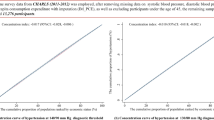Abstract
The Caribbean nation of Cuba is comprised of over 10 million persons who trace their ancestry primarily to Africa and Spain. To date, little data on blood pressure (BP) or hypertension prevalence from Cuba have appeared in English language journals. Because the current government has pursued an active policy of reducing social differentiation on the basis of ethnic origin, Cuba provides an important population laboratory from which to advance the understanding of black–white differences in BP and hypertension. The authors conducted a population-based random sample among adults (aged >15 years) in the city of Cienfuegos. Overall response rate was 95%, yielding 1633 participants who provided BP readings, self-reported racial group, demographic information, and treatment status. Overall prevalence of hypertension (SBP ⩾140 mm Hg or DBP ⩾90 mm Hg or currently treated) was 44% (46% among blacks and 43% whites; P = 0.19). Excess BP among black subjects was reduced slightly by excluding those under treatment, but attained statistical significance after adjustment for sex and age (P = 0.01). The black–white difference was small, however, relative to that observed in the United States. Racial differences in treatment status and control were also observed. Although there remains a difference in socioeconomic profile between those of African and of European origin in Cuba, this has decreased over recent decades. In the United States, the greater magnitude of social differentiation parallels a greater relative risk of BP elevation among blacks, suggesting that social, economic and psychological factors may play an important role in the observed racial gap in cardiovascular risk.
This is a preview of subscription content, access via your institution
Access options
Subscribe to this journal
Receive 12 digital issues and online access to articles
$119.00 per year
only $9.92 per issue
Buy this article
- Purchase on Springer Link
- Instant access to full article PDF
Prices may be subject to local taxes which are calculated during checkout
Similar content being viewed by others
Author information
Authors and Affiliations
Rights and permissions
About this article
Cite this article
Ordúñez-García, P., Espinosa-Brito, A., Cooper, R. et al. Hypertension in Cuba: evidence of a narrow black–white difference. J Hum Hypertens 12, 111–116 (1998). https://doi.org/10.1038/sj.jhh.1000562
Received:
Revised:
Accepted:
Published:
Issue Date:
DOI: https://doi.org/10.1038/sj.jhh.1000562
Keywords
This article is cited by
-
Blacks and whites in Cuba have equal prevalence of hypertension: confirmation from a new population survey
BMC Public Health (2013)
-
Prevalence, awareness, treatment and control of hypertension in the Palestinian population
Journal of Human Hypertension (2013)
-
Prevalence, awareness, treatment and control of hypertension in Vietnam—results from a national survey
Journal of Human Hypertension (2012)
-
An international comparative study of blood pressure in populations of European vs. African descent
BMC Medicine (2005)
-
Blood pressure demographics: nature or nurture ... ... genes or environment?
BMC Medicine (2005)



